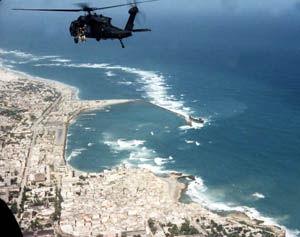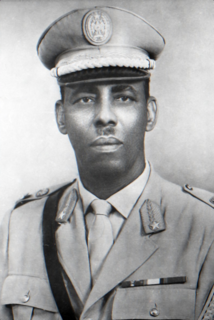Gubyaley | |
|---|---|
Archaeological site | |
| Country | |
| Region | Sool |
| District | Las Anod |
| Time zone | UTC+3 (EAT) |
Gubyaley is an archaeological site in the Sool region of Somaliland.
Gubyaley | |
|---|---|
Archaeological site | |
| Country | |
| Region | Sool |
| District | Las Anod |
| Time zone | UTC+3 (EAT) |
Gubyaley is an archaeological site in the Sool region of Somaliland.
Gubyaley is situated in the Las Anod District, near Goan Bogame. The site features a well with markings on its walls, which are similar to the camel brands used today by Somali herders. Beneath the various symbols are inscriptions that are believed to be associated with the markings. [1] [2]
Djibouti is a country in the Horn of Africa. It is bordered by Somaliland to the southeast, Eritrea and the Red Sea to the north and northeast, Ethiopia to the west and south, and the Gulf of Aden to the east.

Somalia, officially the Federal Republic of Somalia, is a country in the Horn of Africa. It is bordered by Ethiopia to the west, Djibouti to the Northwest, the Gulf of Aden to the north, the Indian Ocean to the east, and Kenya to the southwest. Somalia has the longest coastline on Africa's mainland. Its terrain consists mainly of plateaus, plains, and highlands. Hot conditions prevail year-round, with periodic monsoon winds and irregular rainfall. Somalia has an estimated population of around 15 million, of which over 2 million live in the capital and largest city Mogadishu, and has been described as Africa's most culturally homogeneous country. Around 85% of its residents are ethnic Somalis, who have historically inhabited the country's north. Ethnic minorities are largely concentrated in the south. The official languages of Somalia are Somali and Arabic. Most people in the country are Muslims, the majority of them Sunni.

The Horn of Africa (HoA) is the easternmost peninsula of the African continent, excluding African islands. It lies along the southern boundary of the Red Sea and extends hundreds of kilometers into the Gulf of Aden, Somali Sea and Guardafui Channel.

The Battle of Mogadishu, also known as the Black Hawk Down incident, was part of Operation Gothic Serpent. It was fought on 3–4 October 1993, in Mogadishu, Somalia, between forces of the United States—supported by UNOSOM II—and Somali militiamen loyal to Mohamed Farrah Aidid. It was part of the broader Somali Civil War, which had intensified since 1991 and threatened famine; the UN had become engaged to provide food aid, but eventually shifted their mission to establish democracy and restore a secure government.

Jaalle Mohamed Siad Barre was a Somali General who served as the President of the Somali Democratic Republic from 1969 to 1991. Barre, a major general of the gendarmerie, became President of Somalia after the 1969 coup d'état that overthrew the Somali Republic following the assassination of President Abdirashid Ali Shermarke. The Supreme Revolutionary Council military junta under Barre reconstituted Somalia as a one-party Marxist–Leninist communist state, renaming the country the Somali Democratic Republic and adopting scientific socialism, with support from the Soviet Union.

Djibouti is the national anthem of Djibouti.It was adopted after Djibouti gained independence from France.

The French Territory of the Afars and the Issas was the name given to present-day Djibouti between 1967 and 1977, while it was still an overseas territory of France. The area was formerly known as French Somaliland.

Las Khorey is a historic coastal town in the Sanaag region of Somalia.

The Ogaden War, or the Ethio-Somali War, was a Somali military offensive between July 1977 and March 1978 over the Ethiopian occupied Ogaden, which began with the Somali invasion of Ethiopia. The Soviet Union disapproved of the invasion and ceased its support of Somalia, instead starting to support Ethiopia. Ethiopia was saved from a major defeat and a permanent loss of territory through a massive airlift of military supplies worth $1 billion, the arrival of between 12,000 and 24,000 Cuban troops sent by Fidel Castro to win a second African victory, and 1,500 Soviet advisors, led by General Vasily Petrov. On 23 January 1978, Cuban armored brigades inflicted the worst losses the Somali forces had ever taken in a single action since the start of the war. The Ethiopians and Cubans prevailed at Harar, Dire Dawa and Jijiga, and began to push the Somalis systematically out of the Ogaden. By 23 March 1978, the Ethiopians and Cubans had recaptured more than two-thirds of the Ogaden, marking the official end of the war.

The Ajuran Empire, also spelled Ajuuraan Empire, and often simply as Ajuran, was a Somali empire in the medieval times in the Horn of Africa that dominated the trade in northern Indian ocean. They belonged to the Somali Muslim sultanate that ruled over large parts of the Horn of Africa in the Middle Ages. Through a strong centralized administration and an aggressive military stance towards invaders, the Ajuran Empire successfully resisted an Oromo invasion from the west and a Portuguese incursion from the east during the Gaal Madow and the Ajuran-Portuguese wars. Trading routes dating from the ancient and early medieval periods of Somali maritime enterprise were strengthened or re-established, and foreign trade and commerce in the coastal provinces flourished with ships sailing to and coming from many kingdoms and empires in East Asia, South Asia, Europe, the Near East, North Africa and East Africa.

In archaeology, earthworks are artificial changes in land level, typically made from piles of artificially placed or sculpted rocks and soil. Earthworks can themselves be archaeological features, or they can show features beneath the surface.
Garre is an Afro-Asiatic language spoken by the Garre people inhabiting southern Somalia, Ethiopia and northern Kenya. It belongs to the family's Cushitic branch, and has an estimated 2.5 million speakers. Garre language is considered an ancient Somali dialect.Af-Garre is in the Digil classification of Somali dialects.. Garre language is readily intelligible to Digil speaker as it has some affinity with Af-Maay and Af-Boon.

Djibouti, officially the Republic of Djibouti, is a country located in the Horn of Africa. It is bordered by Somaliland in the south, Ethiopia in the southwest, Eritrea in the north, and the Red Sea and the Gulf of Aden in the east. Across the Gulf of Aden is Yemen. The country has a total area of 23,200 km2 (8,958 sq mi).

El Ayo, also known as El Ayum, is a coastal town in the eastern Sanaag region of Somaliland, near the border with Somalia.

Somali mythology covers the beliefs, myths, legends and folk tales circulating in Somali society that were passed down to new generations in a timeline spanning several millennia. Many of the things that constitute Somali mythology today are traditions whose accuracy have faded away with time or have transformed considerably with the coming of Islam to the Horn of Africa.

Somali architecture is the engineering and designing of multiple different construction types such as stone cities, castles, citadels, fortresses, mosques, temples, aqueducts, lighthouses, towers and tombs during the ancient, medieval and early modern periods in Somalia and other regions inhabited by Somalis, as well as the fusion of Somalo-Islamic architecture with Western designs in contemporary times.

Somali art is the artistic culture of the Somali people, both historic and contemporary. These include artistic traditions in pottery, music, architecture, woodcarving and other genres. Somali art is characterized by its aniconism, partly as a result of the vestigial influence of the pre-Islamic mythology of the Somalis coupled with their ubiquitous Muslim beliefs. However, there have been cases in the past of artistic depictions representing living creatures such as the golden birds on the Mogadishan canopies, the ancient rock paintings in Somaliland, and the plant decorations on religious tombs in Somalia, but these are considered rare. Instead, intricate patterns and geometric designs, bold colors and monumental architecture was the norm.

Karinhegane is an archaeological site in the eastern Sanaag region of Somaliland. It contains some unique polychrome rock art.

Goan Bogame is an archaeological site in the eastern Sool region of Somaliland.
Golharfo is an archaeological site in the Sool region of Somaliland.